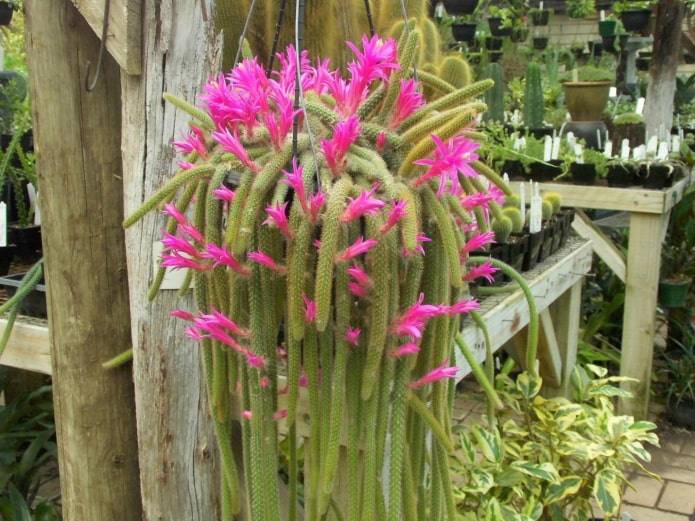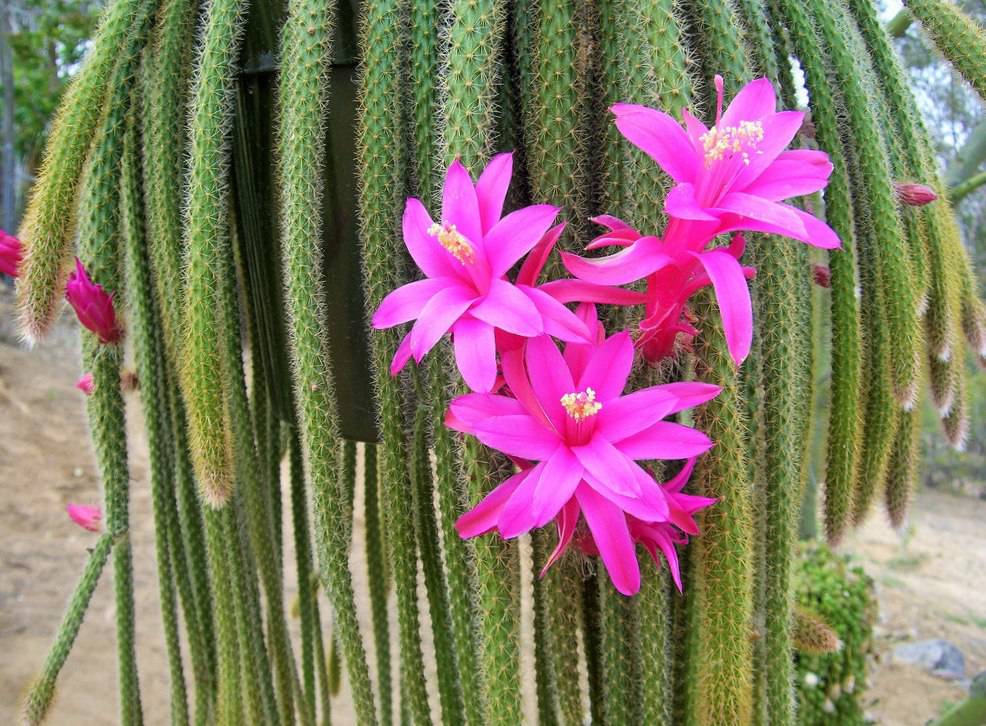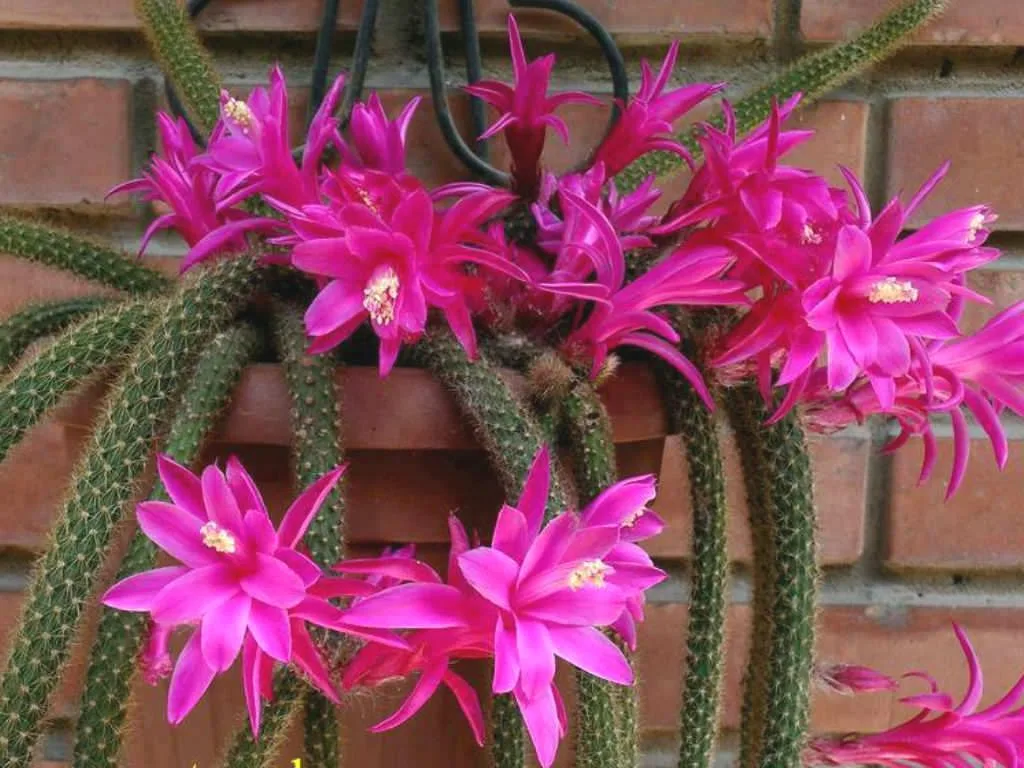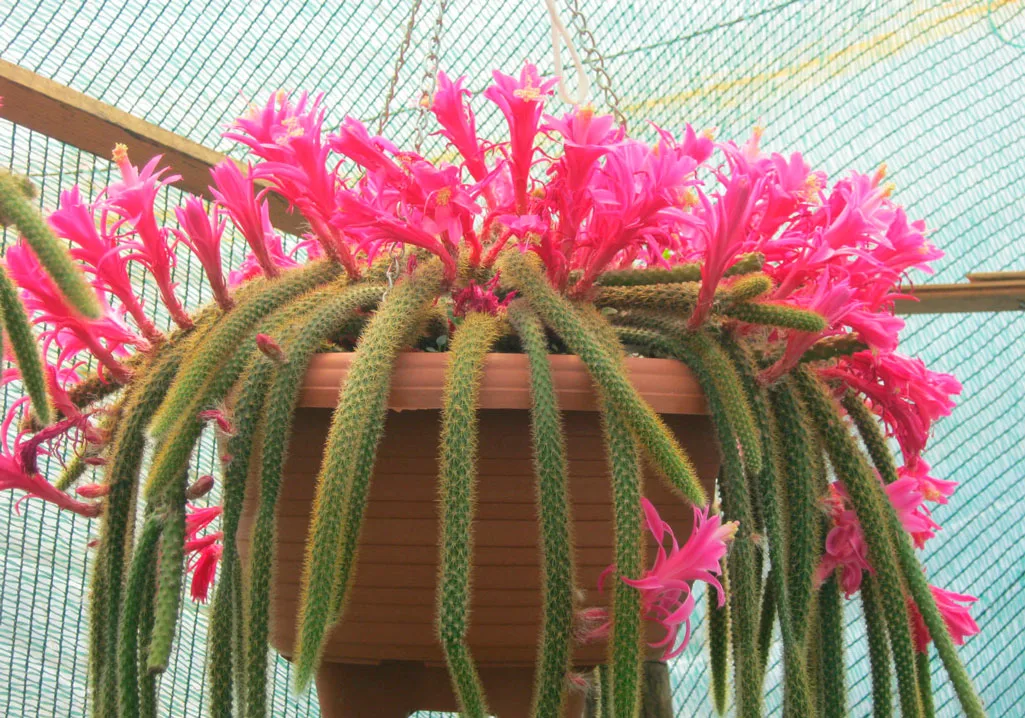Contents
Introduction
The Rat’s Tail Cactus, scientifically known as Disocactus flagelliformis, is a botanical gem that captivates plant enthusiasts with its unique and graceful appearance. Originally from Mexico, this hanging cactus is characterized by thin, flexible stems that extend like tails, providing a suspended elegance when grown in pots. Its dazzling flowers, which bloom along the stems, feature a palette of vibrant colors, from pink to red, transforming any space into an enchanted garden.
Meaning of the Rattail Cactus
In addition to its visual beauty, the Rattail Cactus carries symbolic meanings in the language of flowers. This cactus is associated with grace and adaptability, symbolizing the ability to face adversity with flexibility and delicacy. Growing the Rattail Cactus isn’t just about appreciating an exotic plant; it’s about immersing yourself in a botanical experience that celebrates the harmony between natural beauty and the ability to adjust smoothly to the surrounding environment.
| Common Name | Mouse Tail Cactus |
|---|---|
| Botanical Name | Disocactus flagelliformis |
| Family | Cactaceae |
| Plant Type | Hanging succulent |
| Adult size | Up to 60 cm long |
| Sun exposure | Indirect light in full sun |
| Soil type | Well-drained |
| soil pH | Slightly acidic to neutral |
| Flowering time | Spring to summer |
| Flower color | Varies from pink to red |
| Native Area | Mexico |
| Toxicity | Non-toxic |

How to Care for the Rattail Cactus
Caring for the Rattail Cactus means enjoying the pendulous elegance of this unique succulent. Follow these guidelines to ensure successful cultivation and lush flowering.
Adequate light
Place the Rattail Cactus in indirect light in full sun. This plant appreciates bright light, but avoid prolonged exposure to strong sunlight.
Well-drained soil
Use a succulent mix or create a well-drained soil by adding sand. This prevents water from accumulating in the roots.
Moderate Watering
Maintain a moderate watering approach, allowing the soil to dry out between waterings. Avoid overwatering to prevent root rot problems.
Controlled Temperature and Humidity
Keep the environment at temperatures between 18°C and 24°C. This succulent adapts well to environments with low humidity.
Strategic fertilization
Fertilize during spring and summer with a balanced fertilizer for succulents. Avoid excesses so as not to harm the plant.
By following these guidelines, you will promote an ideal environment for the healthy growth and exuberant flowering of the Rattail Cactus.
How to Cuttings Rattail Cactus
- Healthy Choice: Opt for healthy, mature stems to ensure robust seedlings.
- Careful Cutting: Use a sharp blade to cut healthy segments from the stems.
- Healing: Let the seedlings heal in a dry place for a few days before planting.
How to Plant the Rattail Cactus
- Choosing a pot: Opt for pots with drainage holes to prevent water accumulation.
- Soil Preparation: Use a succulent mix or add sand to ensure good drainage.
- Ideal Positioning: Plant the seedlings so that the roots are slightly below the surface of the soil.
- Moderate Initial Watering: After planting, water sparingly to establish the new plants.
By following these steps, you will succeed in propagating and planting the Rattail Cactus, ensuring a hanging garden full of elegance and beauty.

Pests and diseases
Keep your Rattail Cactus healthy and vibrant by knowing the most common pests and diseases that can affect this charming succulent. Here’s a comprehensive list, along with effective solutions to ensure the health of your plant.
Common Pests
- Mealybugs: Remove by hand or use an insecticidal soap solution.
- Mites: Increase humidity and use neem oil for control.
- Slugs and snails: Remove by hand and keep the soil dry to discourage them.
Common diseases:
- Powdery Mildew: Increase air circulation and use fungicides if necessary.
- Root rot: Replant in well-drained soil and adjust watering practices.
- Leaf spots: Remove affected leaves and avoid watering over the leaves.
Common problems and solutions:
- Yellowing Leaves: Adjust watering and check soil drainage.
- Wilted Leaves: Water properly and adjust frequency as necessary.
- Slow Growth: Fertilize moderately during the growing season.
By proactively dealing with these challenges, you will keep your Rattail Cactus robust and flourishing, providing an ideal environment for its healthy growth.
Curiosities and Myths
Explore the fascinating universe of the Rattail Cactus as we delve into the intriguing curiosities that make this succulent unique. At the same time, we’ll uncover some common myths associated with this captivating plant.
Captivating Curiosities:
- Remarkable Longevity: The Rattail Cactus can live for decades with proper care, making it a long-term companion.
- Genius Adaptation: Its flexible, hanging stems are not only aesthetically appealing, but also a genius adaptation for survival in its native habitat.
Myths Debunked:
- Requires Lots of Sun: Although it likes light, the Rattail Cactus tolerates partial shade, disproving the myth that it needs full sun all the time.
- Uncontrolled Growth: Contrary to the idea of rapid growth, this succulent grows slowly, maintaining a manageable size.
By uncovering these curiosities and debunking myths, you will develop a deeper understanding and appreciation for the fascinating world of the Rattail Cactus on your gardening journey.

Conclusion
In summary, the Rattail Cactus reveals itself not only as an aesthetic addition to your garden, but as a witness to the grace of nature in its most unique form. Its hanging stems and vibrant flowers are testimony to the adaptability and longevity that this succulent provides. By following precise care, from adequate lighting to solutions for pests and diseases, you guarantee not only a visually enchanting garden, but also a long-lasting and rewarding experience with a truly unique plant.
In this botanical journey, curiosities uncovered and myths dispelled highlight the complexity and genius behind the Rattail Cactus. By understanding its nature and enjoying its beauty, you connect more intimately with the magic that flora offers. In this way, we celebrate not just an outstanding cactus, but a natural masterpiece that continues to surprise and inspire, reinforcing the eternal fascination of the plant kingdom.
Frequently Asked Questions
Can flowers even grow on the Rattail Cactus?
Yes, it is possible for small flowers to bloom on the Rattail Cactus. Despite their hardy reputation and spiky appearance, these cacti can produce delicate flowers, usually located at the ends of their segments.
What time of year do Rattail Cacti bloom?
Rattail cacti usually bloom during spring and early summer. This period is ideal for the development of flowers, and many specimens of this species bloom during this time. The amount of sunlight, temperature and other environmental factors play a crucial role in this process.
How long does a Rattail Cactus flower last?
The duration of a Rattail Cactus flower is relatively short, usually persisting for a few days to a week. Flower ephemerality is a common feature of many cactus species, and the short flowering period is part of the life cycle of these plants adapted to arid and semi-arid environments.
.








